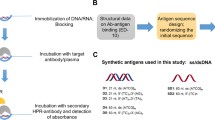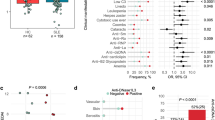Abstract
Catalysis by antibodies could be a frequent phenomenon if the immune system generates a sufficiently diverse number of antibodyactive sites, some of which may possess catalytic activity. A catalytic antibody can be expected to do more damage than one that simply binds antigen. The best biochemical marker of systemic lupus erythematosus (SLE) is presence of autoantibodies to DNA. In the present article, we describe the DNA-hydrolyzing activity of DNA-binding autoantibodies purified from SLE patients. The substrates employed were supercoiled plasmid, radiolabeled plasmid fragments, and oligonucleotides. Hydrolysis of DNA by the antibodies was indicated by the appearance of fragments visualized by ethidium bromide staining of agarose gels or autoradiography of polyacrylamide gels. Changes in linear dichroism values were also indicative of DNA hydrolysis. The antibody activity was purified by protein A-sepharose chromatography, high-performance liquid chromatography gel filtration, and DNA-affinity chromatography. Scrupulous control studies were done to demonstrate that DNA-hydrolyzing activity really belongs to the antibodies. Purified Fab fragments showed hydrolyzing activity, whereas the Fc fragment was inactive. The specificity of DNA cleavage was investigated, and the rate parameters of hydrolysis by antibodies and conventional nucleases were compared.
Similar content being viewed by others
References
Paul, S., Volle, D. J., Beach, C. M., Johnson, D. R., Powell, M. J., and Massey, R. J. (1989),Science 244, 1158–1161.
Shuster, A. M., Gololobov, G. V., Kvashuk, O. A., Bogomolova, A. E., Smirnov, I. V., and Gabibov, A. G. (1992),Science 256, 665–667.
Bronstein, I. B., Shuster, A. M., Shevchenco, L. V., Gromova, I. I., Kvashuk, O. A., Geva, O. M., and Gabibov, A. G. (1989),Moleculamnya Biologin (in Russian). 23. 1553–1557.
Stevens, S. Y., Swanson, P. C., Voss, E. W., Jr., and Glick, G. D. (1993),J. Am. Chem. Soc. 115, 1585,1586
Joron, L., Izadyar, L., Friboulet, A., Remy, M. H., Pancino, G., Roseto, A., and Thomas, D. (1992),Ann. NY Acad. Sci. 672, 216–223.
Stollar, B. D. (1988),Int. Rev Immunol. 5, 1–22.
Herron, J. N., He, X. M., Ballard, D. W., Pace, P. E., Bothwell, A. L. M., Voss, E. W., and Edmundson, A. B. (1991),Proteins 11, 159–175.
Paul, S., Volle, D. J., Powell, M. J., and Massey, R. J. (1991),J. Biol. Chem. 266, 16, 128–16, 134.
Harlow, E. and Lane, D. (1988),Antibodies. Cold Spring Harbor Laboratory Press, Cold Spring Harbor, NY, 628.
Cleland, W. W. (1970), inThe Enzymes, vol.2, Boyer, P., ed., Academic Press, New York, p. 1.
Modrich, P. and Zabel, D. (1976),J. Biol. Chem. 251, 5866–5872.
Holloman, W. K. (1973),J. Biol. Chem. 248, 8114–8121.
Author information
Authors and Affiliations
Rights and permissions
About this article
Cite this article
Gabibov, A.G., Gololobov, G.V., Makarevich, O.I. et al. DNA-hydrolyzing autoantibodies. Appl Biochem Biotechnol 47, 293–303 (1994). https://doi.org/10.1007/BF02787941
Issue Date:
DOI: https://doi.org/10.1007/BF02787941




